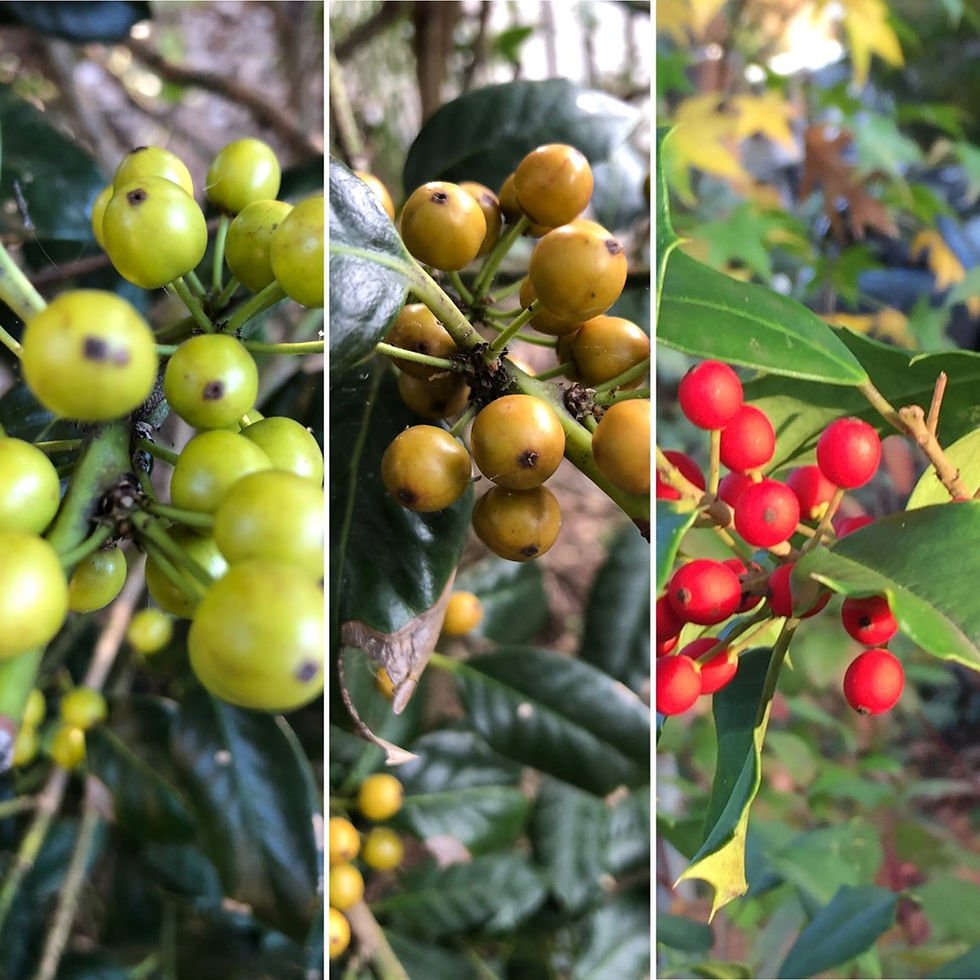Layering Native Evergreens for Winter
- Nuts for Natives
- Jan 30, 2020
- 3 min read

Winter is the perfect time to spot where your garden may need evergreens for interest and structure. Hollies (Ilex opaca), Eastern red cedar (Juniper Virginiana), eastern white pine (Pinus strobus) and hemlock (Tsuga canadensis) are awesome native trees that sustain your local birds, insects and wildlife and are easy to grow. These are large trees. Native hollies grow 15 to 30 feet tall in cultivation and up to 50 feet tall in the wild. Eastern red cedar grows to 30 to 65 feet tall depending on location. Hemlocks grow to 70 feet. Even larger is the eastern white pine grows 50 to 80 feet tall.
Our garden is 1/8 of an acre so using too many of these taller natives would be out of scale. For more moderately sized gardens like ours, it’s helpful to layer in smaller native evergreens. Layering is recommended by experts like Doug Tallamy and Rick Darke as a practical way to add native plants to your garden. Here are a few that seem to grow well in the Chesapeake watershed.
Dwarf eastern pine (Pinus strobus ‘Nana’) is a wonderful way to add an eastern pine to a smaller scaled garden or bed. There are many types of ‘nana,’ the smaller size, available.

Eastern red cedar ‘Grey Owl’ (Juniperus virginiana ‘Grey Owl‘) is a small version of eastern red cedar and very easy to find in native plant nurseries and garden centers. It grows a couple of feet high and 4 to 6 feet wide in full sun.

Dwarf hollies (Ilex opaca ‘Maryland Dwarf‘) are terrific for smaller gardens. They look very much like the native holly, just more diminutive. These easy care native trees provide year round interest and grow in sun and part shade. They bear small white flowers in spring. Red berries feed birds in fall and winter. You can also get great cut branches with berries. Homestead Gardens in Davidsonville, MD says this is a plant they typically carry during certain times of the year.

Northern white cedar (Thuja occidentalis) is common on the east coast from New York north. It also grows sporadically south to North Carolina. This is a graceful, tall evergreen tree that is also available in compact sizes. Morton Arboretum lists a number of cultivars. Some are smaller trees and some are very small shrubs like the sphere pictured above. These are generally good for full sun locations and need virtually no care once established. They also work well for a more formal effect.
There are several evergreen shrubs that add excellent winter interest. My favorite is Inkberry (Ilex glabra). It grows in sun or partial shade. Inkberry is an excellent native substitute for ornamental boxwood and much easier to care for. Also check out northern bayberry (Myrica Pennsylvanica) for sunny areas and partial shade and mountain laurel (Kalmia latifolia) for shade. These three evergreen shrubs are commonly available at garden centers and native plant nurseries.
Evergreen natives out in the garden
Doug Tallamy says you can add more trees and shrubs to your garden than you think you can. This corner of our 1/8 acre garden faces a busy intersection and we have added many evergreens for interest and screening. These are relatively recently planted but should fill in overtime while still allowing for deciduous shrubs and perennials. Without them, in winter, the garden bed would disappear.
From left to right: American holly, dwarf eastern arborvitae, eastern arborvitae, common juniper, eastern red cedar, inkberry, magnolia “Little Gem’ (Magnolia Grandiflora ‘Little Gem’)
Buying small scaled native evergreens
Finding smaller native evergreen trees may take more than a casual trip to your garden center. Compact plants like Eastern red cedar ‘grey owl,’ pines and hollies, northern white cedars, inkberry, bayberries (not to be confused with invasive barberries) and mountain laurels are commonly available at garden centers and native plant nurseries.
Smaller specimens of trees are available on-line from nurseries and you can find them with a google search. You may want to contact your preferred garden center to request they order what you are looking for. Most are happy to try to help. Early winter is a great time to do this as nurseries are placing their plant orders.
For more info:
On designing for winter interest generally from Fine Gardening magazine.
The Missouri Botanical Garden lists several dwarf forms of Hemlock.





























Comments